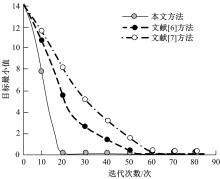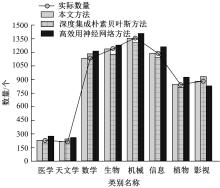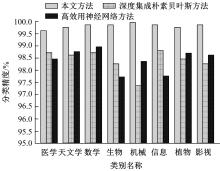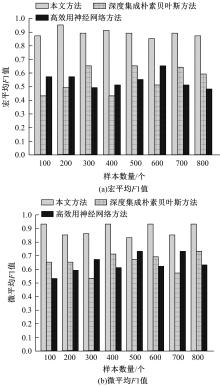Journal of Jilin University(Engineering and Technology Edition) ›› 2022, Vol. 52 ›› Issue (8): 1889-1895.doi: 10.13229/j.cnki.jdxbgxb20210167
Unbalanced text classification method based on deep learning
Xiao-ying LI1( ),Ming YANG1,Rui QUAN2,Bao-hua TAN3(
),Ming YANG1,Rui QUAN2,Bao-hua TAN3( )
)
- 1.Industrial Design Engineering,Hubei University of Technology,Wuhan 430068,China
2.Hubei Key Laboratory for High-Efficiency Utilization of Solar Energy and Operation Control of Energy Storage System,Hubei University of Technology,Wuhan 430068,China
3.School of Science,Hubei University of Technology,Wuhan 430068,China
CLC Number:
- TP391
| 1 | 陈志, 郭武. 不平衡训练数据下的基于深度学习的文本分类[J]. 小型微型计算机系统, 2020, 41(1): 1-5. |
| Chen Zhi, Guo Wu. Text classification based on deep learning under unbalanced training data[J]. Mini Computer System, 2020, 41(1): 1-5 | |
| 2 | 汤景泰, 陈秋怡. 意见领袖的跨圈层传播与“回音室效应”——基于深度学习文本分类及社会网络分析的方法[J]. 现代传播(中国传媒大学学报), 2020, 286(5): 31-39. |
| Tang Jing-tai, Chen Qiu-yi. Cross circle communication of opinion leaders and "echo room effect"— a method based on deep learning text classification and social network analysis[J]. Modern Communication (Journal of Communication University of China), 2020, 286(5): 31-39. | |
| 3 | 汪少敏, 杨迪, 任华. 基于深度学习的文本分类系统关键技术研究与模型验证[J]. 电信科学, 2018, 34(12): 123-130. |
| Wang Shao-min, Yang Di, Ren Hua. Key technology research and model validation of text classification system based on deep learning[J]. Telecom Science, 2018, 34(12): 123-130. | |
| 4 | 崔昕阳, 龙华, 熊新, 等. 基于并行双向门控循环单元与自注意力机制的中文文本情感分类[J]. 北京化工大学学报: 自然科学版, 2020, 47(2): 115-123. |
| Cui Xin-yang, Long Hua, Xiong Xin, et al. Sentiment classification of Chinese texts based on parallel bidirectional gating cycle unit and self attention mechanism[J]. Journal of Beijing University of Chemical Technology(Natural Science Edition), 2020, 47(2): 115-123. | |
| 5 | 李杰, 李欢. 基于深度学习的短文本评论产品特征提取及情感分类研究[J]. 情报理论与实践, 2018, 41(2): 143-148. |
| Li Jie, Li Huan. Feature extraction and sentiment classification of short text reviews based on deep learning[J]. Intelligence Theory and Pactice, 2018, 41(2): 143-148. | |
| 6 | 吴皋, 李明, 周稻祥, 等. 基于深度集成朴素贝叶斯模型的文本分类[J]. 济南大学学报: 自然科学版, 2020, 149(5): 17-23. |
| Wu Gao, Li Ming, Zhou Dao-xiang, et al. Text classification based on deep integration naive Bayesian model[J]. Journal of Jinan University(Natural Science Edition), 2020, 149(5): 17-23. | |
| 7 | 吴玉佳, 李晶, 宋成芳, 等. 基于高效用神经网络的文本分类方法[J]. 电子学报, 2020, 48(2): 279-284. |
| Wu Yu-jia, Li Jing, Song Cheng-fang, et al. Text classification method based on efficient neural network[J]. Acta electronica Sinica, 2020, 48(2): 279-284. | |
| 8 | 马喆康, 迪力亚尔·帕尔哈提, 早克热·卡德尔, 等. 一种集成深度学习模型的旅游问句文本分类算法[J]. 计算机工程, 2020, 520(11): 76-82. |
| Ma Zhe-kang, Parharti Diliar, Kader Zaokere, et al. A text classification algorithm for tourism questions based on integrated deep learning model[J]. Computer Engineering, 2020, 520(11): 76-82. | |
| 9 | 孟先艳, 崔荣一, 赵亚慧,等. 基于双向长短时记忆单元和卷积神经网络的多语种文本分类方法[J]. 计算机应用研究, 2020, 347(9): 115-119. |
| Meng Xian-yan, Cui Rong-yi, Zhao Ya-hui, et al. Multilingual text classification method based on bidirectional long short time memory unit and convolutional neural network[J]. Computer Application Research, 2020, 347(9): 115-119. | |
| 10 | 郑炜, 陈军正, 吴潇雪, 等. 基于深度学习的安全缺陷报告预测方法实证研究[J]. 软件学报, 2020, 31(5): 58-77. |
| Zheng Wei, Chen Jun-zheng, Wu Xiao-xue, et al. An empirical study on security defect report prediction method based on deep learning[J]. Acta Sinica Sinica Sinica, 2020, 31(5): 58-77. | |
| 11 | 王丽亚, 刘昌辉, 蔡敦波,等. CNN-BiGRU网络中引入注意力机制的中文文本情感分析[J]. 计算机应用, 2019, 39(10): 2841-2846. |
| Wang Li-ya, Liu Chang-hui, Cai Dun-bo, et al. Chinese text sentiment analysis with attention mechanism in CNN bigru network[J]. Computer Applications, 2019, 39(10): 2841-2846. | |
| 12 | 谢红玲, 奉国和, 何伟林. 基于深度学习的科技文献语义分类研究[J]. 情报理论与实践, 2018, 41(11):149-154. |
| Xie Hong-ling, Feng Guo-he, He Wei-lin. Semantic classification of scientific and technological literature based on deep learning[J]. Information Theory and Practice, 2018, 41(11): 149-154. | |
| 13 | 宋化志, 马于涛. DeepTriage:一种基于深度学习的软件缺陷自动分配方法[J]. 小型微型计算机系统, 2019, 40(1): 128-134. |
| Song Hua-zhi, Ma Yu-tao. Deeptriage: an automatic software defect allocation method based on deep learning[J]. Mini Computer System, 2019, 40(1): 128-134. | |
| 14 | 董丽丽, 杨丹, 张翔. 基于深度学习的大规模语义文本重叠区域检索[J]. 吉林大学学报: 工学版, 2021, 51(5): 1817-1822. |
| Dong Li-li, Yang Dan, Zhang Xiang. Large-scale semantic text overlapping region retrieval based on deep learning[J]. Journal of Jilin University(Engineering and Technology Edition), 2021, 51(5): 1817-1822. | |
| 15 | 翟玲,崔旭.基于分段估计和PageRank的文本信息相似性搜索算法[J].吉林大学学报:工学版,2022,52(4):910-915. |
| Zhai Ling, Cui Xu. Text information similarity search algorithm based on segment estimation and PageRank [J] Journal of Jilin University(Engineering and Technology Edition), 2022, 52 (4): 910-915. |
| [1] | Tian BAI,Ming-wei XU,Si-ming LIU,Ji-an ZHANG,Zhe WANG. Dispute focus identification of pleading text based on deep neural network [J]. Journal of Jilin University(Engineering and Technology Edition), 2022, 52(8): 1872-1880. |
| [2] | Xuan-jing SHEN,Xue-feng ZHANG,Yu WANG,Yu-bo JIN. Multi⁃focus image fusion algorithm based on pixel⁃level convolutional neural network [J]. Journal of Jilin University(Engineering and Technology Edition), 2022, 52(8): 1857-1864. |
| [3] | Gui-he QIN,Jun-feng HUANG,Ming-hui SUN. Text input based on two⁃handed keyboard in virtual environment [J]. Journal of Jilin University(Engineering and Technology Edition), 2022, 52(8): 1881-1888. |
| [4] | Ming-hua GAO,Can YANG. Traffic target detection method based on improved convolution neural network [J]. Journal of Jilin University(Engineering and Technology Edition), 2022, 52(6): 1353-1361. |
| [5] | Ling ZHAI,Xu CUI. Text information similarity search algorithm based on segment estimation and PageRank [J]. Journal of Jilin University(Engineering and Technology Edition), 2022, 52(4): 910-915. |
| [6] | Yong LIU,Lei XU,Chu-han ZHANG. Deep reinforcement learning model for text games [J]. Journal of Jilin University(Engineering and Technology Edition), 2022, 52(3): 666-674. |
| [7] | Ji-hong OUYANG,Ze-qi GUO,Si-guang LIU. Dual⁃branch hybrid attention decision net for diabetic retinopathy classification [J]. Journal of Jilin University(Engineering and Technology Edition), 2022, 52(3): 648-656. |
| [8] | Xue WANG,Zhan-shan LI,Ying-da LYU. Medical image segmentation based on multi⁃scale context⁃aware and semantic adaptor [J]. Journal of Jilin University(Engineering and Technology Edition), 2022, 52(3): 640-647. |
| [9] | Lin SONG,Li-ping WANG,Jun WU,Li-wen GUAN,Zhi-gui LIU. Reliability analysis based on cyber⁃physical system and digital twin [J]. Journal of Jilin University(Engineering and Technology Edition), 2022, 52(2): 439-449. |
| [10] | Jie CAO,Jia-lin MA,Dai-lin HUANG,Ping YU. A fault diagnosis method based on multi Markov transition field [J]. Journal of Jilin University(Engineering and Technology Edition), 2022, 52(2): 491-496. |
| [11] | Gui-xia LIU,Zhi-yao PEI,Jia-zhi SONG. Prediction of protein-ATP binding site based on deep learning [J]. Journal of Jilin University(Engineering and Technology Edition), 2022, 52(1): 187-194. |
| [12] | You QU,Wen-hui LI. Single-stage rotated object detection network based on anchor transformation [J]. Journal of Jilin University(Engineering and Technology Edition), 2022, 52(1): 162-173. |
| [13] | Jie ZHANG,Wen JING,Fu CHEN. Vulnerability detection of instant messaging network protocol based on passive clustering algorithm [J]. Journal of Jilin University(Engineering and Technology Edition), 2021, 51(6): 2253-2258. |
| [14] | Dong-ming SUN,Liang HU,Yong-heng XING,Feng WANG. Text fusion based internet of things service recommendation for trigger⁃action programming pattern [J]. Journal of Jilin University(Engineering and Technology Edition), 2021, 51(6): 2182-2189. |
| [15] | Li-li DONG,Dan YANG,Xiang ZHANG. Large⁃scale semantic text overlapping region retrieval based on deep learning [J]. Journal of Jilin University(Engineering and Technology Edition), 2021, 51(5): 1817-1822. |
|
||







